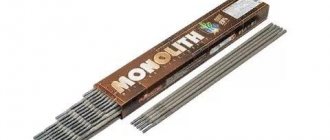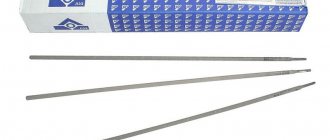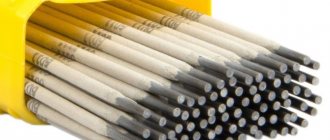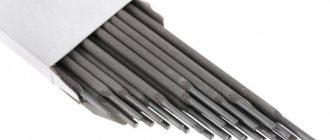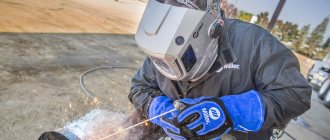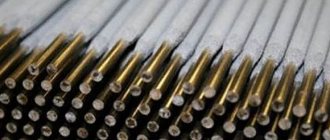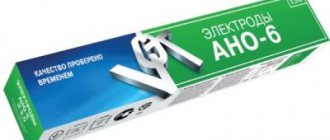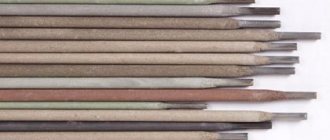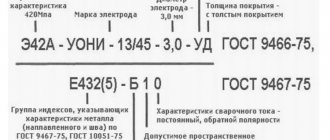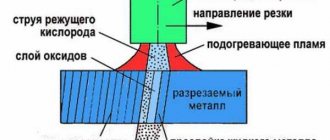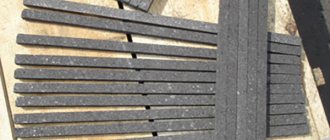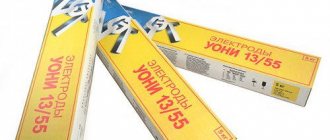Non-consumable electrodes are used for manual or automatic welding of steel and non-ferrous alloys in a protective gas environment. To form a weld, filler wire is used, which melts under the influence of an arc discharge. The use of a protective atmosphere reduces the risk of the formation of harmful impurities that negatively affect the quality of welding.
Non-consumable electrodes are widely used for gas shielded electric arc welding.
When were non-consumable electrodes created?
The idea of using non-consumable carbon electrodes for welding metals was first put forward by the Russian inventor N. N. Benardos in 1882. Since the work was carried out without supplying inert gas to the melt zone (despite the appearance of the first patents in 1890), the quality of the joint saturated with particles carbon was low. For this reason, at the beginning of the 20th century, consumable electrodes with a coating that protected the weld became widespread.
In 1920, the first installations appeared that made it possible to work with non-consumable tools in a protective gas environment (TIG technology). Later, electrodes made of tungsten-based alloys began to be produced, which made it possible to increase the current strength and stabilize the arc. To protect the seam from the influence of atmospheric air, inert gases (for example, argon or helium or mixtures of these materials) were used.
Characteristics of non-consumable electrodes
Tungsten electrodes have a diameter from 2 to 6 mm and tips shaped like an elongated cone with a blunt top (for direct current) or a sphere (for alternating power). The tool is sharpened manually or on machines with a guide for installing the rod. The electrodes are designed for use with direct (the negative pole is connected to the parts being welded) or reverse polarity, and can be operated on alternating current (in this case there is no concept of polarity).
The electrodes are designed to use alternating current.
Scope of application
Technology used:
- for continuous connection of thin sheets of material;
- joining large-sized elements made of carbon, alloy steels or non-ferrous metals;
- welding steel blanks with parts made of non-ferrous alloys;
Non-consumable electrodes are used for welding steel workpieces.
Non-consumable electrodes are used for welding metal containers for the aviation, space, food or oil refining industries. The technology allows welding structures made of titanium, nickel, bronze with a high silicon content.
The technique can be used when applying a coating of one material to the surface of another.
Types of consumables
To perform the work, electrodes with a high melting point are used, exceeding the threshold for the transition to the liquid phase of the workpieces being welded and the temperature of the arc discharge. In addition to graphite or carbon rods, tools made of pure tungsten or alloys based on it are used. The electrode material is selected depending on the thickness and chemical composition of the parts being welded.
We recommend reading General characteristics and design features of surfacing electrodes type T590
Graphite
This type is resistant to high temperatures and has increased durability compared to carbon rods. Used for industrial welding of copper cores of cables or parts made of copper or aluminum based alloys. Electrodes can be used to connect structures made of steels with low carbon content (the seam does not have high mechanical strength) or to seal defects in cast iron castings.
Graphite electrodes for welding are infusible.
Coal
They are used for air-arc cutting of steel sheets or to eliminate defects on the surfaces of thick-walled workpieces (both with the supply of filler material and without wire). The current in the circuit is up to 600 A (enough to heat structural and low-alloy steels to the melting point). Intended for industrial use, not found in household welding machines.
Carbon electrodes are intended for industrial use.
Tungsten
The products are intended for household or industrial use; they allow joining parts made of different metals in an inert gas environment. Argon arc welding is carried out with electrodes with a core with a diameter of 1-4 mm, coated with a protective coating. Since the melting point of tungsten is higher than the arc temperature, the tool does not wear out and allows welding alloy steel sheets. To change the performance characteristics, additives (for example, thorium, yttrium or lanthanum oxide) are introduced into the metal composition of the tool.
In accordance with GOST 23949-80, the following types of electrodes are produced:
- EHF – made of pure metal tungsten without alloying;
- EVL – with the introduction of 1.1-1.4% lanthanum oxide;
- EVI - using 1.5-3.5% yttrium oxide;
- EVT - containing 1.5-2.0% thorium dioxide (they are characterized by low radioactivity and are rarely used for welding special structures).
Tungsten electrodes are intended for household use.
The applicability of alternating and direct current depends on the brand of electrodes. For example, EHF series rods are designed to supply only alternating voltage. Other products can operate at any current and with direct or reverse polarity. It should be taken into account that during the welding process, the refractory core gradually burns out (for example, for a tungsten rod, the norm is to reduce the length by 10 mm over 5 hours of continuous operation).
Use of tungsten electrodes
Today, few people use graphite and carbon rods at home for welding and cutting; it is simply impractical. But tungsten rods are very often used in households when welding aluminum and other non-ferrous metals and stainless steel. These are the consumables that make the connection
Welding modes with a non-consumable electrode in shielding gases are determined by many factors: the type of metal, its thickness, protective atmosphere and others.
The table contains the main types of tungsten rods, their use and the corresponding mode.
This is the Western classification of tungsten rods. Domestic manufacturers produce non-consumable electrodes under the designations EVL and EVI (lanthanum and yttrium rods). Rods from pure EHF tungsten are also produced.
The ends are also marked with color depending on the purpose of the consumable. The current strength and mode depend on the metal and the characteristics of the workpiece. For example, aluminum must be cooked using alternating current, and steel must be cooked in one mode or another. Stainless steel is welded using direct current, just like copper products.
It is also important to establish polarity when using non-consumable electrodes. Direct polarity - the torch cable is placed on the minus, and the ground on the plus; reverse polarity - the holder is on the plus, and the ground on the minus.
The polarity mode determines the shape of the welded metal. With direct polarity and direct current, the penetration is deep and narrow; with constant polarity and reverse, there is a wide surface penetration, and with alternating current, it is oval.
If rods marked EHF (clean) are used, then welding can be carried out only on alternating current; all others (EVI, EVL, EVT) can be carried out in one mode or another with the required polarity.
During the welding process, tungsten becomes dull and needs to be sharpened. The tip angle is maintained at 30 degrees with a length of 2-3 electrode diameters. The tip itself is dulled by 0.5 millimeters.
Despite the name, such electrodes still have their own degree of consumption, albeit insignificant. For example, with uninterrupted operation for 5 hours, a tungsten rod loses about 10 mm of its length. To reduce this figure, welding must be started by supplying gas and then igniting the arc. Also, do not tap the tip of a non-melting rod directly on the workpieces. The arc is ignited on graphite and transferred to the welding site.
What can you add to the material in this article? What types of non-consumable electrodes are most often used at home? Share your experience in selecting this type of consumable and its use in the comments section for this article.
As any specialist knows, for welding performed in an argon environment, tungsten electrodes are used, which are classified as non-consumable. They are distinguished by a wide variety of types, each of which is identified by markings applied to these products during the production process.
Pros and cons of operation
Advantages of the technology of using non-consumable rods:
- increased stability of the arc discharge in a protective gas environment, independent of the connection polarity;
- when forming a weld, the share of the base metal (melt from the body of the workpiece) varies from 0 to 100%;
- the possibility of changing the chemical composition in the connection line is provided (due to the introduction of filler wire of different types);
- applicability for welding workpieces made of steel of any category or non-ferrous metals or their alloys;
- the ability to connect parts made of dissimilar materials (for example, stainless steel and aluminum);
- it is possible to adjust the geometry of the joint by changing the angle of installation of the tool and the feed speed;
- reduced temperature impact zone, reducing the risk of deformation and cracking;
- the seam does not require cleaning from flux and scale, or grinding.
We recommend reading Where OZL-6 electrodes are used
Non-consumable electrodes are suitable for welding steel workpieces.
The disadvantages of non-consumable arc welding (TIG) include:
- increased energy consumption (compared to equipment for working with consumable electrodes);
- the need to use special installations for igniting the arc;
- accelerated cooling of the connection line, leading to the formation of shrinkage cracks;
- a problem with the supply of shielding gas to the working area when welding outdoors in windy weather;
- the need for preliminary cutting of edges;
- difficult welding at sharp angles to the surface due to the configuration of the torch;
- the presence of a trace from arc ignition outside the welding zone, requiring subsequent cleaning;
- saturation of the weld material with carbon (applies to technologies using graphite or carbon electrodes).
Melting view
Manual arc welding using a consumable electrode is classified as a universal approach, since it can be carried out in almost any conditions.
This method of organizing the welding process allows the operator to work comfortably even in the most inaccessible places. However, along with these advantages, this method has a number of significant disadvantages, manifested in the following:
- small depth of penetration of the processed metal;
- low productivity of the welding process, which is explained by low levels of operating currents;
- instability of manual welding, which is noticeably inferior to automated fusion techniques.
The essence of this metal processing method is to use the energy of an electric arc artificially created between the workpiece being welded and the electrode.
Under the influence of high temperatures, the metal in the welding zone intensively melts and forms a so-called “welding pool”. At the final stage of work, a neat seam should be obtained at the site of the melt (after it has cooled).
In appearance, a consumable electrode is a typical metal rod with a coating of a certain structure and thickness applied to its surface.
The main parameters that determine the dimensions of the so-called “coated” electrodes, their breakdown by type and the requirements for them are regulated by current standards (GOST 9467-75, in particular).
According to these data, the most common diameter of electrode rods is in the range from 3 to 6 millimeters. The indicated indicator is defined as the thickness of the rod, without taking into account the existing working coating.
With a decrease in this value, as well as with an increase in the total length of the electrode, its conductivity also changes, which naturally leads to strong heating during the welding process.
If overheated, the rod quickly melts (it is said to begin to “flow”). At the same time, the organic components included in the coating burn, losing their protective properties.
Welding equipment
For manual welding with a tungsten electrode, a machine with a head is used, inside of which there is a replaceable core. A cap with a pipeline for supplying inert gas and power to the contact tube on the electrode is installed on top. The arc burns in the gap between the tip of the refractory rod and the parts being connected, the generated heat melts the edges and the filler rod. The equipment imposes increased requirements on the qualifications of the welder, who must maintain the arc and at the same time feed the wire to form a strong seam.
For manual welding, a machine with a head is used.
Household devices for working with a tungsten electrode consist of components:
- a housing containing a source of direct or alternating current (there is equipment with the ability to select the type of power supply);
- manual replaceable torch with a dielectric holder (collet dimensions depend on the diameter of the electrode and the value of the welding current);
- a gas nozzle made of a ceramic composite that can withstand prolonged heating to high temperatures (it is possible to use a gas lens that forms a laminar flow);
- containers for storing gas and hoses for supplying a protective atmosphere to the burner;
- oscillator providing arc ignition.
The equipment may contain additional devices that control the welding process (for example, turning on the gas supply until the arc is ignited). There are devices that support pulse welding, allowing you to obtain a seam in the form of a sequence of points superimposed on each other.
The welder manually adjusts the pulse duration, achieving a uniform connection of parts.
Features of non-consumable electrode arc welding technology
The TIG process involves the use of alternating or direct current (TIG-AC and TIG-DC, respectively); when using direct voltage, the negative terminal is connected to the part or tool (straight and reverse polarity). For reverse polarity, electrodes with an increased core diameter are used. The use of alternating current negatively affects the stability of the arc; the technology is designed for connecting parts made of aluminum and magnesium alloys.
Recommended reading: Using SSSI electrodes
The heat balance of the welding process depends on the chosen polarity. With direct connection, up to 85% of the arc power is spent on heating and melting the workpiece material and filler wire; with reverse switching, the parameter is reduced to 50%. To increase the operating efficiency of devices with alternating current supply, electronic discharge stabilizers are used.
Arc welding technology is designed for joining parts made of aluminum alloys.
The arc length is maintained within the range of 1.5-3.0 mm, the voltage in the power circuit is 20-35 V. The tip of the non-consumable tool has an overhang within the range of 3-5 mm; when making fillet welds, the parameter can be increased to 5-7 mm. Depending on the thickness of the material being welded, use the left or right position of the nozzle on the burner, which provides the supply of inert gas.
Marking of welding electrodes and their interpretation
To figure out which electrodes are presented in front of you, you should study their markings. Each package contains information about 9 main characteristics in accordance with GOST 9466-75.
- Types of coated electrodes for welding. High-strength steels, with a large proportion of carbon, high or low percentages of alloys, are welded with electrodes marked starting with the symbol E - electrode, then there are numbers indicating the maximum permissible tensile loads (kgf_mm2), at the end there is an index A - indicating increased stability seam to plastic and impact loads. For example: E 42, E 50, E46 A, E 60, etc. Heat-resistant and high-alloy steels: symbol E, numbers after the dash indicating the amount of carbon, followed by letters and numbers indicating a specific chemical element (A - nitrogen, M-molybdenum, F - vanadium, etc.) and its amount in hundredths . Chemical components are arranged in descending order of their quantity in the product. For example: E-09M; E-10ХЗМ1БФ; E-30G2ХМ, etc.
- Brands of electrodes for welding Brands are an individual parameter and depend solely on the manufacturer.
- Diameter The thickness of the inner part of the coated electrode ranges from 1.6 to 12 mm; in everyday life, thicknesses of 3-5 mm are most often used.
- Purpose Manufactured to work with carbon steels and with a low number of impurities, as well as strength up to 60 kgf/m2, the electrodes are marked with the letter - U; Alloyed structural steels with a tensile strength above 60 kgf/m2 are welded with products marked - L; Products for steels with low thermal conductivity are marked with the letter - T; Metals with a large proportion of impurities and unique properties can be welded with products marked – B; Surfacing layers with unique characteristics are produced by products marked - N.
- Coating Thickness A value indicating the ratio of the thickness of the coating to the inner rod. If this ratio is less than 1.2, then the product is marked with the symbol M and classified as thinly coated; the middle layer ranging from 1.2 to 1.45 is marked with the symbol C; thick - from 1.45 to 1.8 are marked with the symbol D and finally the thickest, the ratio of which is more than 1.8, is marked with the mark G.
- Basic properties of the weld The exact properties of the alloys, for each type these values are their own and indicate the strength, percentage composition of impurities, operating temperature of the weld and a number of other indicators. These values can be found in the corresponding tables with interpretations.
- Type of electrode coating A – acid coating. B – calcium fluoride. C – cellulose. R – rutile. F – increased iron content. There are also mixed types of electrode coatings, which are marked with several letters based on the composition.
- Marking of spatial positions 1 – all, 2 – all except vertical, downward; 3 – lower, plus vertical (bottom-up movement); 4 – exclusively lower.
- Type of welding current and connection – Index 0 electrodes for direct current and reverse connection; – index 1,4, 7 – indicates products for any type of voltage and any connections; – indicators – 2,5,8 – any current, but the connection must be direct; – indexes – 3,6,9 for any currents and reverse connection.
We recommend! Types of electrodes for cast iron. How to make it yourself
Features of working in a gas environment
Requirements when performing welding with a non-consumable electrode in an inert gas environment:
- Electric arc welding with a tungsten rod is performed with the tip deeply immersed in the joint line between the workpieces. The resulting short arc allows you to obtain a strong connection and does not have a negative impact on the original characteristics of the metal of the parts.
- Mechanized welding involves moving the electrode by a power drive at a given speed; the tip should be located along the center line of the future weld (both vertically and horizontally). Deviations to the sides lead to a decrease in the strength of the joint line, lack of penetration and deterioration in the appearance of the structure.
- The filler wire and electrode tip are located inside a protective gas torch, which prevents saturation of the heated and molten metal with atmospheric oxygen and nitrogen. If the supply of inert gas is disrupted, the joint line becomes brittle due to the penetration of foreign impurities deep into the material.
- The filler wire is fed from the side of the weld pool, which prevents boiling of the material and the formation of spatter. If manual arc welding is carried out in a shielding gas environment, the rod is carefully fed at an angle to the surface of the parts being joined.
- The gas supply is turned on and off 10 seconds before the start of arc ignition and after the end of welding. A pause is necessary to reduce the consumption of electrode material, uniformly cool the melt and prevent the formation of an oxide film on the surface.
- The surfaces to be joined must be cleaned of rust and traces of dirt with a wire brush; any oil stains found must be removed with an organic solvent. Before starting welding, you need to set the operating mode of the device (welding current and connection speed depend on the thickness of the workpieces, the type and diameter of the electrode).
Manual and automated work
To achieve a positive result, you should responsibly choose electrodes for argon arc welding. Standard electrodes are used, both undergoing melting and remaining in a solid state. Non-consumable products are made from tungsten, a metal known for its refractoriness.
A tungsten non-consumable rod, under the influence of a pulse, initiates ignition of the arc and ensures its stability. Ignition is stimulated by a high-frequency high-voltage pulse from the oscillator.
As a result, the inert medium is ionized, and after turning on the welding current, the arc ignites. When argon arc welding with alternating current, the oscillator after ignition performs the function of a stabilizer. At the moment of polarity changes, it sends impulses to maintain a stable arc.
The non-consumable electrode does not take part in the formation of the seam. If necessary, filler wires are used for this.
There are the following main types of welding in argon:
- completely manual technology (abbreviated TIG);
- process with automatic supply of consumables (abbreviated as MIG, in German WIG).
Domestic manufacturers use GOST to designate electrode products. In international practice, English abbreviations are used.
